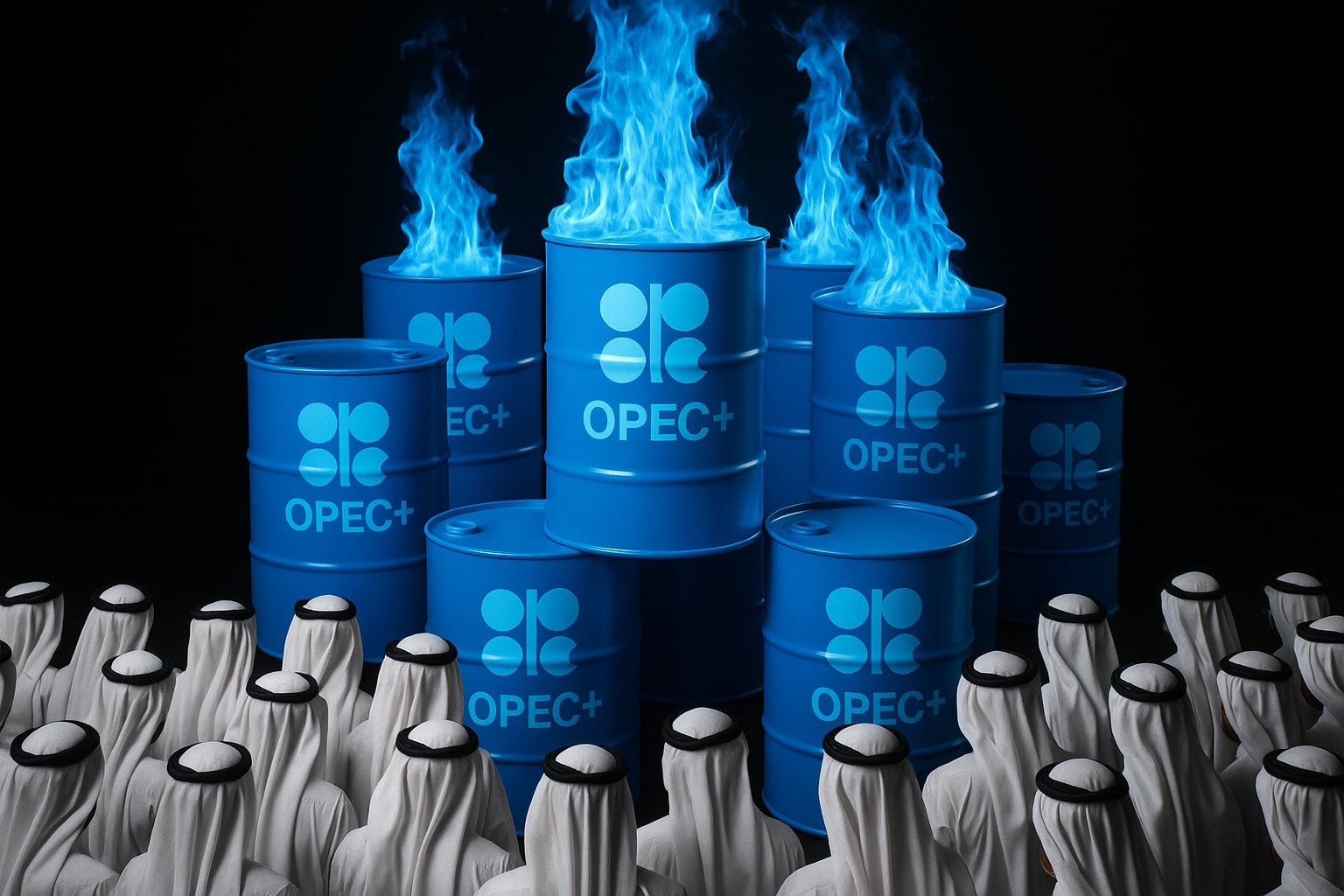
Oil Price Forecast - Oil Prices Slide as WTI Holds $58.46, Brent Ticks to $63.15 and Azeri Light Drops Sharply
A fractured market emerges with WTI at $58.46, Brent at $63.15 and Azeri Light falling to $65.43 as surging Russian exports | That's TradingNEWS
Oil Price Dislocation Intensifies As WTI, BRENT And Global Supply Signals Clash
WTI trades near $58.46 and CL=F edges toward $58.85, while BZ=F pushes to $63.15, revealing a widening divergence between U.S. and global benchmarks at the exact moment Azeri Light collapses to $65.43 after losing 3.47% in a single session. The fractured pricing structure now reflects the combined weight of rising inventories, a heavy Russian shadow-fleet system moving sanctioned barrels, and fresh IEA warnings that the 2026 surplus will be even larger than projected just weeks ago. This fractured market forces traders to reprice supply risk downward and treat rallies as short-lived unless OPEC+ responds decisively.
Russian Crude Floods Global Channels As Sanctions Reshape Shipping Lines
Russian barrels continue to depress the entire OIL complex, with sanctioned tankers transporting 44% of all Russian crude in October — the largest share since the conflict escalated. Revenues sink to €524 million per day, the lowest since the invasion, while the “shadow fleet” increases ship-to-ship transfers inside EU waters by 35%, adding an estimated €112 million per day in shipments routed through opaque flags. China absorbs 47% of Russia’s crude, India takes 38%, and Türkiye dominates refined product imports at 26%, cementing a flow pattern that keeps non-OPEC barrels abundant even as sanctions expand.
WTI Strengthens Slightly As U.S. Inventories Surprise With A 2.1 Million-Barrel Draw
The EIA’s unexpected 2.1 million-barrel inventory draw injects a small bullish impulse into WTI and CL=F, briefly lifting prices back above $58.40 after flirting with deeper lows. This draw contradicts earlier fears of a Q4 demand slowdown and arrives while the Dollar Index falls toward 99.00, making dollar-denominated barrels cheaper globally. However, these supportive forces are overshadowed by the IEA’s new projection that global supply will expand another 3.1 million barrels per day in 2025 and 2.5 million barrels per day in 2026, creating structural oversupply that suppresses any sustained WTI breakout.
Brent Recovers But Faces Pressure From Urals Discounts And Expanding Non-OPEC Supply
BRENT trades at $63.15, up 0.70%, but the recovery is shallow because Russia’s Urals crude trades at only a $4.92 discount, narrowing despite sanctions and reinforcing that refineries still find Russian supply economically irresistible. Urals averaged $59 in October, well above the new $47.6 price cap enforced by Europe and its allies. The IEA confirms that non-OPEC+ producers will account for 1.7 million barrels per day of next year’s supply growth, ensuring that even aggressive OPEC+ cuts may be insufficient to stabilize Brent above the mid-$60s without a stronger demand backdrop.
Azeri Light’s Drop To $65.43 Flags Regional Weakness As Its Historical Range Amplifies Risk
Azeri Light sliding $2.35 to $65.43 underscores the weakness in medium-sweet grades that normally command higher premiums. This benchmark once peaked at $149.66 (July 2008) and bottomed at $15.81 (April 2020). The current price sits at the lower end of its post-2022 range, reflecting soft refinery margins in Europe, reduced Turkish product exports, and rising competition from discounted Russian feedstock. India’s sanctioned Vadinar refinery alone increased Russian crude imports by 32%, operating at 90% capacity — directly displacing Azerbaijani barrels and accelerating today’s price drop.
Read More
-
CoreWeave Stock Price Forecast - CRWV Shares Falls to $79.30 as Delays, Debt and AI Volatility Collide With Explosive $55.6B Backlog
13.11.2025 · TradingNEWS ArchiveStocks
-
XRP Price Forecast - XRP-USD Steadies Above $2.30 as ETF Debut Triggers a High-Stakes Pivot
13.11.2025 · TradingNEWS ArchiveCrypto
-
Natural Gas Price Surges Toward Multi-Year Highs as $4.60 Breakout Collides With Winter Demand
13.11.2025 · TradingNEWS ArchiveCommodities
-
Stock Market Today - Nasdaq 22,959 Crashes as Tech Unravels— DIS Stock –8.8% & NVDA Stock –4% Hit Markets Hard
13.11.2025 · TradingNEWS ArchiveMarkets
-
GBP/USD Price Forecast - Pound Climbs Toward 1.3200 as Dollar Weakens and UK Data Sparks Major Repricing
13.11.2025 · TradingNEWS ArchiveForex
OPEC+ Prepares For December Talks As The Market Questions Whether Cuts Can Reverse The Trend
Ahead of the December 4 OPEC+ meeting in Vienna, speculation intensifies that deeper cuts may be announced to protect WTI, BRENT, and Middle Eastern grades from sliding into the low-$50s by Q1 2026. But internal dynamics complicate the picture: supply from both OPEC+ and non-OPEC+ has surged by 6.2 million barrels per day since January. Even if OPEC+ removes another 1 million barrels per day, the IEA’s projected 4.09 million-barrel surplus for 2026 casts doubt on the effectiveness of any intervention. This is why markets fade rallies quickly — structural oversupply dominates short-term diplomacy.
Demand Signals Split Between China’s Industrial Uptick And European Contraction
China’s October industrial output rising 4.6% keeps Asia’s crude appetite broadly supported and stabilizes long-haul flows. But Europe’s industrial production continues to contract, suppressing diesel demand and weighing on BRENT and Azeri Light more than on WTI. In the U.S., refinery runs remain steady, but the broader market remains anchored by recession concerns following the U.S. government shutdown, which ended only after 43 days, leaving macro data delayed and investor positioning cautious. The bifurcation between Asian resilience and Western stagnation remains one of the defining forces behind today’s disjointed price action.
Sanctioned Barrels Reshape Trade Routes And Reinforce The Global Oil Surplus
The rise of “shadow” fleets — 117 vessels moving Russian crude and products — distorts tanker availability and accelerates the buildup of unsold barrels. Aging ships, many more than 20 years old, amplify environmental risk and deepen the uncertainty premium that traders apply when assessing seaborne supply stability. Ship-to-ship transfers account for €112 million per day, signaling that Russia is adapting its export strategy regardless of Western restrictions. These workarounds ensure that CL=F and BZ=F remain weighed down even when inventory data or currency moves briefly support them.
IEA’s New Forecast Forces A Market Reset As Traders Brace For Glut Conditions
The IEA’s updated projections confirm that 2026 will face a larger surplus than initially expected, lifting the implied balance from 3.97 million barrels per day to 4.09 million barrels per day. Demand growth remains weak at 790,000 barrels per day in 2025 and 770,000 barrels per day in 2026, levels far below the post-pandemic recovery pace. With global supply ramping sharply and inventories steadily rising, oil markets lose the bullish structural narrative that supported the $80–$90 ranges of past cycles. This shift pulls WTI, BRENT, and alternative grades toward a new equilibrium centered in the $55–$65 corridor unless OPEC+ reshapes expectations.
U.S. Shutdown End And Funding Deal Offer Temporary Stability But Not Enough To Lift Prices
The end of the U.S. shutdown removes one source of uncertainty, yet traders remain cautious because key indicators like CPI, PPI and retail sales were delayed for more than a month. Risk models still reflect the possibility of slower winter demand, limiting upside for WTI and CL=F despite currency tailwinds. The modest rebound observed in today’s session appears more like a technical reset than a fundamental shift — especially with the IEA’s supply revisions overshadowing the macro relief.
Oil Price Stance After Mixed Signals Across WTI, BRENT And Global Benchmarks
With CL=F holding the high-$58 region, BZ=F struggling to maintain levels above $63, Azeri Light sinking to $65.43, and Urals steady around $59, the market reflects a global surplus dynamic that overshadows short-term catalysts. Structural supply growth, aggressive Russian flows, and weak Western demand continue to weigh on the entire complex. A bullish scenario requires coordinated OPEC+ cuts and evidence that inventories begin trending lower. Until then, oil trades inside a range where rallies are sold and breakdown risks remain elevated.


















